
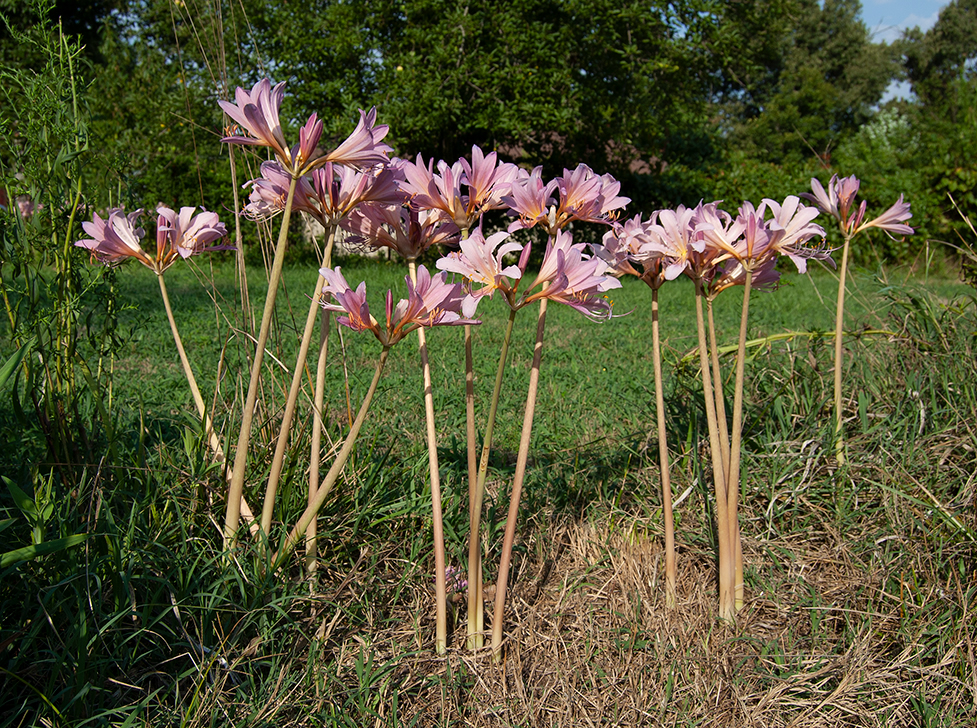
In the Morning Light
Bunches of lilies appeared everywhere on the grounds of the cottage, in beds around the oaks, in front of the woodworking shop, along the back fence, next to the front door of the hacienda, across the road by the dogwood, amidst the patch of poison ivy by the south fence, and under the old apple tree.
3 Dog Acres | rural Washington County, Arkansas
Image by Ebenezer | August 2011
Late Summer Surprise
Gaia's Act of Resurrection
By Ebenezer Baldwin Bowles
24 August 2020
Alive!
They appear as a cluster
of long, thin leaves in early spring,
giving no flower,
then vanish, as if dead,
preparing in the underground
for a late summer resurrection.
Some short time ago . . . .
I looked out the study window. The hawk circled, low in the thin sky, hunting. My eyes drifted downward to a heart-shaped dogwood of graceful green and pleasant visage. A few yards to the left of its two-branched trunk, on the far side of the pale gray lane, I spied a band of lilies, pink and white, swaying in the hot breeze like dancers in a corps de ballet. They were a wonderful late summer surprise.
Their emergence
from the parched earth caught me unawares nine years ago, our first summer at the Cottage. The strange flowers by the dogwood were the first members of a transient, merry band, eventually to number in the many glorious dozens, appearing the last week of July as objects of mystery, arising of a sudden from the dark, rocky soil of a little flower patch out back. We stopped at the patch twice each day, sometimes thrice, to water, prune, and admire the marigolds, morning glories, cosmos, and four o'clocks growing there. Seeing for the first time the strange new lilies, winding toward the sky from whence, the day before, there were none: Amazing.
As long as a man doth prune his vines,
doth dig at the roots,
and doth lay fresh earth to them,
he hath a mind to them,
he perceiveth some token of fruitfulness,
that may be recovered in them.
— Certain Sermons Or Homilies
Appointed To Be Read In Churches
(page 77, The Edition of MDCCCXXII a long time ago)

A Mysterious Emergence
See them, young and precious, tall and slender — green magic wands for gnomes and fairies, precious gifts from the original animist mother, sweet Gaia. The first time they appeared, 2011 it was, I asked the mistress of the hacienda if she knew the identity of the mysterious new plants. Have you seen them on your sunrise walks with the shepherds?
“Yes. They're surprise lilies,” she said. “We used to have them at home in the delta. They sprang up everywhere.”
We are not there, not in the Mississippi River delta…
Not at Swan Lake, not anywhere
In the sea of remembered things
But at the cottage, pretending.
The First Blush
Nine years ago I hadn't a clue — thus the surprise in 2011 when the lilies emerged to my absolute amazement. Surprise of this sort comes but one season only, the first blush — our first summer at Crow's Cottage. Now the perennial visitors strike familiar poses at the end of each and every month of July. I expected them this year. Eagerly. And shall again in 2021.
In the study tonight, I choose to follow the thread of our magic lilies wherever it may lead, and under natural or generated light, come day or come night, from solar fires and furnaces of coal,
and…
by reaper's hook or shepherd's crook,
we arrive at a gateway
to ideas first propounded by Aristotle,
and there we find a passel of questions,
of people and animals and things,
raised-up by the Doctrine of the Ancients:
“Whether genera and species do really exist in nature ?
or,
Whether they are only conceptions of the human mind ?
or,
If they exist in nature,
Whether they are corporeal or incorporeal ?
and,
Whether they are inherent
in the objects of sense,
or disjoined from them ?
These, he says, are very difficult questions, and require accurate discussion;
but that he is not to meddle with them.”
— Analysis of Aristotle's Logic
With Remarks by Thomas Reid, D.D. F.R.S
(page 7, The Second Edition, Edinburgh: 1806)

The Slippery Slope of Taxonomy
Kingdom: Plantae
Subkingdom: Tracheobionta (vascular plants)
Division: Magnoliophyta (angiosperms — also called flowering plants)
Class: Liliopsida (monocotyledons)
Subclass: Liliidae
Order: Liliales
Family: Liliaceae (the lilies)
Genus: Lycoris (Lycoris Herbert)
Species: squamigera (Maxim.)
Yes, but. . . . The taxonomy shown above is the version declared to be correct by the Natural Resources Conservation Service of the United States Department of Agriculture (USDA). It appears official enough for our purposes here in the laboratory of Crow's Cottage. However, an article on Wikipedia under the title Lycoris squamigera places the plant in the order Asparagales, family Amaryllidaceae. Hence, we stumble into another pitfall in the quest for truth … and if not for truth, then for factual clarity.
When the library here at the Cottage isn't sufficient, and when we aren't inclined to climb into a vehicle and motor on over to the stacks at the university, a thirty-minute drive to the east, we turn inward to the vast World Wide Web, a wondrous expanse of ready information and delightful diversion, but also a punji pit of delusion, error, misdirection, and foolishness. No wonder Luke tells us to separate the wheat from the chaff, which shall burn with fire unquenchable.
One source states this, another source states that. Which source shall the scholar choose to accept as gospel?
Perhaps the serious-minded contributors to Wikipedia are a step ahead of the mainline botanists at USDA, who may ascribe to the adage, “Close enough for government work.” Fashions in science change. Certitudes in most any discipline fall prey to postmodern relativity. Maybe the order Asparagales, family Amaryllidaceae has superseded the lilies in present-day taxonomical jargon. Doubtless we can find an expert to take the affirmative for either side. But today, trustful, we side with the government men.

Fiery Star
And the wand-like lily, which lifted up,
As a Maenad, its moonlight-colored cup
Till the fiery star, which is its eye,
Gazed through clear dew on the tender sky
— Percy Bysshe Shelley, "The Sensitive-Plant," 1820 —
Length, Breadth, Depth, Reach
Continue, then, the inaccurate discussion, meddled and muddled through ’n through: genera and species, Mind and Nature, inherent and disjointed. So what if I can't run with Aristotle — you know it — can't run with one of the Greats in the Pantheon of the Ancients, can't run with a Mind way far beyond mine in length, breadth, depth, and reach — any other form of psychic measurement you can lay on the trestle board and say, “Measure this!” So why try?
“I didn't understand a word of it,” she wrote from the little hamlet at the foot of the great mountain, the atoms swirling in concentric circles at her feet, the bumble bees in concert ’round her hair. I've mentioned this before. It haunts me. Why didn't she understand? Don't tell me it's breaking down that quickly, dementia on the half-shell, fragments too disjointed for the conveyance of meaning, conveyor belts dumping words into a purposeless abyss.
Right away, we limit the response to the kingdom of plants — more narrowly and specifically, to just one of its members, Lycoris squamigera. Already in the space of a few paragraphs, we've given the plant three distinct common names: magic lily, surprise lily, and Resurrection Lily. There are others, too, and some of them fit the taxonomy: autumn lily, rain lily, naked lady. Other published names for Lycoris squamigera are not rightly aligned with botanical fact, including the belladonna lily, Amaryllis belladonna, which is very nearly a mirror image of Lycoris squamigera but somehow deemed by the experts to grow under a different name. I'd need to put them side-by-side in full bloom to discern the difference, but the fair lady of the night is somewhere else, drinking atropine and praying to a merciful god for deliverance from the Second Circle of Hell.
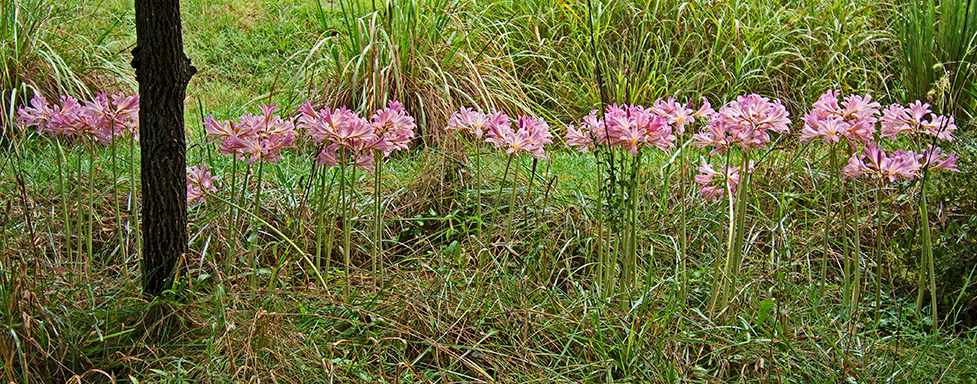
Let It Rain!
One can argue against the name rain lily because it's more commonly associated with the Cooperia drummondii Herbert, the evening rain lily, a white flower of late summer with tall naked stems. Here in the Ozark highlands, the Lycoris squamigera oft emerge from their slumber after a good summer rain, and several of our pals like to call them rain lilies.
We, too. We accept the privilege of liking many a good name, Sir.
Some include spider lily in the list of names for Lycoris squamigera, a lazy but understandable error. Lycoris radiata, the spider lily, is the surprise lily's closest cousin. I wish they'd come visit our garden.
Searching for the Essence of a Thing
The relationship between the Resurrection Lily and the spider lily reveals a fundamental purpose of taxonomy. As Professor Reid writes in his treatise on Logic, “Now, the essence of a thing consists of these two parts: first, What is common to it with other things of the same kind; and, secondly, What distinguishes it from other things of the same kind. The first is called the genus of the thing, the second is its specific difference. The definition, therefore, consists of these two parts.”
Here in the study, over there in the laboratory, out there in the world — Hello World! It is me. I exist. — we are snared by the passion to travel so long and so deep as to arrive at the essence of a thing. It becomes a passion forever unfulfilled, a quest for the ineffable that by nature remains unuttered in both thought and word, but Thanks be to God for His ineffable grace. We continue, n’er to give up.

Petals, Stamens, and the Style of the Resurrection Lily:
Look carefully. I count six stamens. The extra-long, dark purple tentacle must be the style of the pistil. If correct, this analysis fits the symmetry of the lily, which features six petals.
Not!
Botanists tell us three of the petal-like structures in the corolla are actually sepals. So, looking alike, three petals and three sepals form the whorl of the brightly colored thing we see, collectively, as the flower.
Growing in Beauty and Grace
Here
on the screen of a monitor,
zeroes and ones, on and off,
not a page but the representation of a page,
here
the only valid reality emerges from the imagination,
imago on wings of maturated recorded language,
and here
every notion of genre and species extends from Mind.
There is no lily, no row of elegant ballerinas on a stage.
Though I saw them, I remember!
lilies growing in beauty and grace,
yesterday and last week,
rising in all directions toward the sky,
saw the Russian dancers,
the sorcerer with his curse,
and faithful Odette in love, selling
tickets for a seat in the auditorium,
and here
the tall stalks totter and fall,
the lily flowers are dead or dying,
darkening day by day,
and
Jesus the God Man,
emerging from the tomb to confound death,
walking for forty days among
the children of Israel
and their Roman conquerors,
then ascending toward the clouds below heaven,
then beyond the clouds
to sit at the right hand of the Father,
the sky dogs there with him,
the Lost Boys and all forgotten dreams,
threads of conception from the human Mind.

The Naked Lady's Legs . . . .
Among its many names, the Lycoris squamigera
is known by the bawdy nomen confusum “naked lady.”
Following the logic, she is all legs — the Rockettes of the Gardens.
These legs stood about 55 centimeters tall.
Have you ever died
and gone to heaven?
If so, you are resurrected.
The scenario is unlikely.
My death, our deaths — we are the quick, the only ones here in the dark of night — are psychic events of the spirit and flesh united into a whole being with a Name. We become the ones who die to a corrupted way of life so that another way, a way of promise and freedom, can arise in its place.
And they found the stone rolled away from the tomb.
Oh! Sometimes it causes me to tremble, tremble, tremble.
In the vestry sat the pastor at his desk, the children of the catechism at his feet, each with Luther's little book opened to “The Third Article, Sanctification,” the pastor saying that when they rolled away the stone door of the tomb He was not there, His body not stolen but resurrected, risen from the dead, alive as God and Man in One.
“This is most certainly true,” the pastor spoke, and the little ones believed him, marveled at the red-tinted rays of morning light streaming through the stained-glass cloak on the right arm of Jesus Christ inside the tomb, the filtered light in the vestry the color of blood, falling on the pastor's white hair, and Jesus on the glass with a moustache and beard, and flowing hair of auburn brown, His eyes toward the heavenlies, the fingers of His two hands intertwined in prayer and supplication.
The pastor called one boy to rise and recite,
and the boy said,
"I believe…."
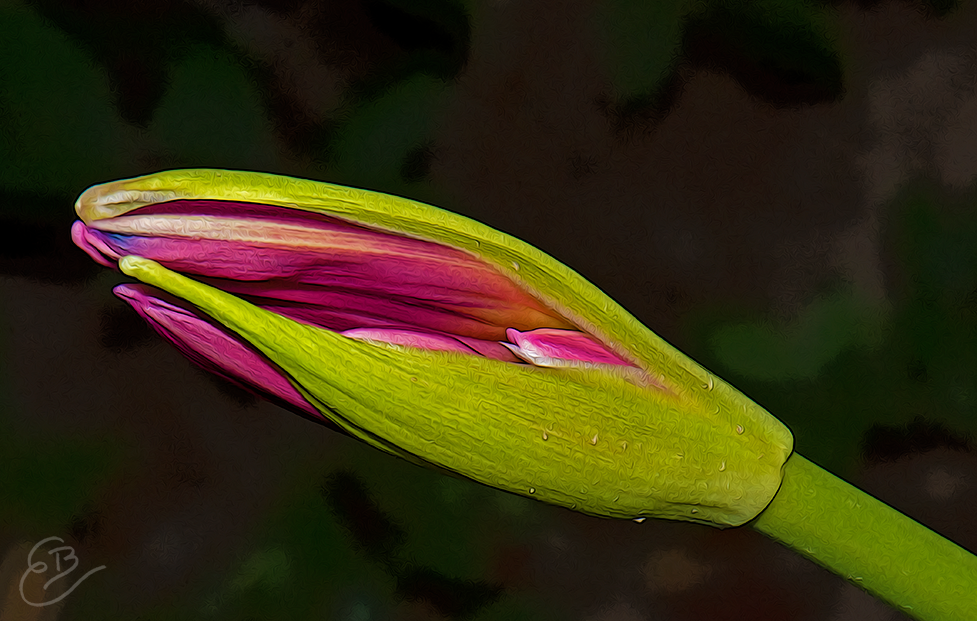
Calyces of the Resurrection Lily
Yet in the bud, each lily flower
is covered by an outer envelope
of unopened petals and sepals
called the calyx.
The ground number of the lily
is three and twice three.
“The calyx is nothing but
the swaddling clothes of the flower,”
John Ruskin wrote in The Ethics of the Dust.
“The child-blossom is bound up in it,
hand and foot.”
Scathe, Scythe, Gravity
Why choose Resurrection over surprise as the Spirit for this tale? Both names are equally valid as the commonplace for Lycoris squamigera. I suppose it's a matter of gravity versus lightness of being, of the heavy heart over light heartedness. So oft I tote the scathe like a ball and chain into the dark night. No wonder I gravitate toward sharers with a lilt on the tongue and a smile on the lips. I need their cheerful disposition to leaven the seriousness. The bud and the bloom I love in my own way. It works well enough to keep me here, well enough to spite the scythe and its wicked intentions.
Not born again,
not rising from the ashes
of an arid existence like the Phoenix bird,
not reincarnated
as a fragment of wandering soul,
arriving to habituate another earthly form,
not brought back to the land of the living
at the end of a near-death experience,
not the dust of the man
reanimated at the gates of heaven
standing for the Last Judgment,
but resurrected,
revived and revitalized from a dead place,
a moment ago,
into the life-giving sunlight of the Spirit. Now.
From emptiness and screaming madness
to rhyme and reason,
merrily merrily merrily some of us go,
dead men walking toward a cleansing Light.
And get there.
He's alive! He's alive! What's next?
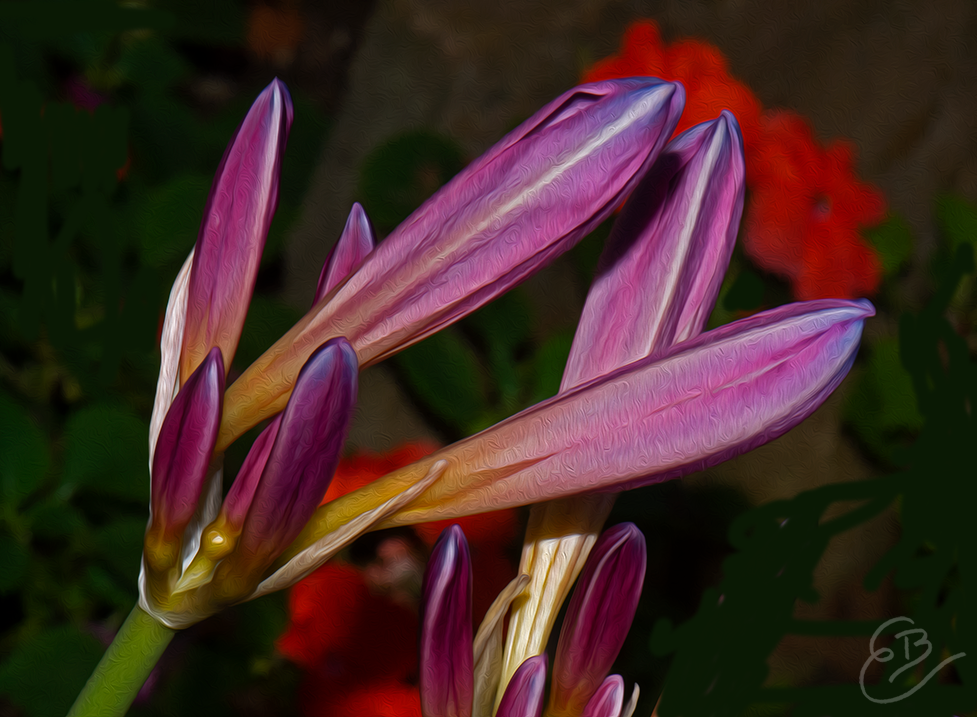
A Mighty Trumpet
For the trumpet shall sound,
and the dead shall be raised incorruptible,
and we shall be changed.
•
When we make the implements
of our work and
our art,
we look to Nature for form and function.
There is room for not much more, little room for more, no space left to discover a hidden law of nature in the life of the lily.
We have meddled enough with difficult questions and the limits of language. These, then, are my pictures of flowers, the altering of perception, not the carnal reality inherent in the things OUT THERE in the garden, but a disjoined notion of it IN HERE in the study, where the words crawl bit-by-bit across the screen, jumping up, jumping down, never seeing ink, and where the images lie flat and distorted in their confinement, where the colors bend and shape like phantoms escaping from an unreal spectrum, and where each and all exist as impermanent expressions of the cosmos, as ephemeral as the light of a single day, and as imperfect as the ability of language to express the soul of man.
Surprise Lilies and Sunset of a Sort
Meet me, Mr. I. Magination,
The man with the magic reputation!
Post Script:
Quick they came that first season at Crow's Cottage. Quick they went. The first Resurrection Lily broke ground at Crow's Cottage on the last day of July 2011. Rising from my chair here in the study on the twelfth day of August, I walked into the gardens and looked around and about — the lilies were gone, the flowers wilted, the long legs fallen to the ground. Yes, but.… Under the Earth, the bulbs awaited their next resurrection. I prayed to be the witness. And I am … every year and this year, nine years later. It's the wonder of the perennial. This year's corps de ballet are dancing yet in the hot days of summer.


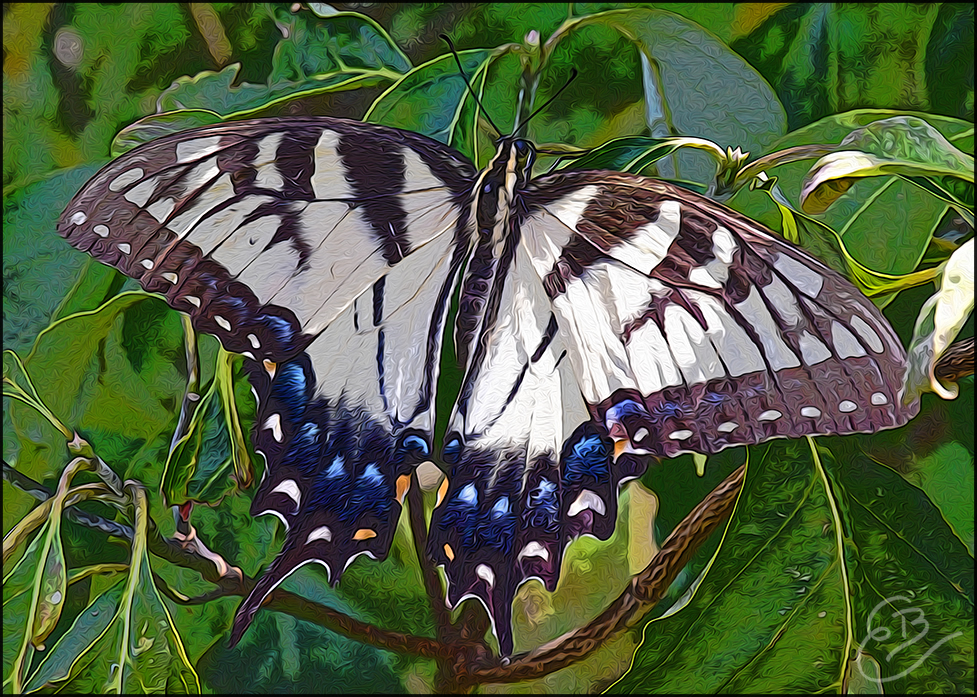
3 Dog Acres | rural Washington County, Arkansas
Tiger Swallowtail (Papilio glaucus) | Image by Ebenezer | 7 July 2017
Tiger Swallowtail? Yes, He Is.
He's a beauty, this Tiger Swallowtail. That he is white may seem strange, given the dominant yellow of the “typical” tiger, but in this case the exception seems natural when you consider the ability of nature to break free of norms and nullify the typical. Frankly, we weren't sure of the identification until the experts at BugGuide.net, an outreach of Iowa State University, confirmed the identity of this pretty tiger.
This creature arrived in front of our camera one sunny summer day in 2017 — and we haven't seen him since. (OK, swallowtails live but a week or two. We were being a little facetious.) His descendants visit the lantana and sage every now 'n then, but only once this season. We call him a “he” because the male swallowtails are showy while the females are typically dressed in darker hues.
We have butterflies on our mind today, an understandable state of affairs in light of reports from friends about an outburst of butterflies in their gardens. Tom and Christie, for instance, have seen thirty, forty, maybe more black swallowtails dining on lantana and other delicacies. Here at the Cottage, a healthy flock of spicebush swallowtails arrived two weeks ago and, to our delight, continue to flutter here ’n there in a relentless quest for nectar.
Alas, three days ago one of the swallowtails flew into the studio and became trapped, futilely bumping against the panes of the bay window in the sunroom. Hopeful, I reached out with my right arm and gently snared the little creature, cradling her in a loose fist and hoping the encounter wouldn't injure her.
Away She Flutters!
I walked to the door of the studio, stepped outside, opened my fist, and presto! Away she fluttered, mercifully returning to her natural environment.
Here at the Cottage, every butterfly, every life (BLM) matters. The older we become, the more conscious we are of the value of insect life … of all life, actually … life enfolding against the storm.
The arrival of the swallowtails in robust numbers inspires shouts of hallelujah! Our friends Dave and Amy, who live a few miles to the south of us, report that their phlox attracted a half-hundred swallowtails one afternoon last week.
Yes, they are out there, but not like they once were. Between now and our arrival at 3 Dog Acres in 2011, insect populations have steadily declined. Ours is what they call anecdotal evidence, but — as far as we're concerned — scientific evidence of declining insect populations worldwide confirms the anecdote here in the Ozark Highlands.
I'm not the most observant naturalist — I tend to see shapes and colors where others see motion and details — but I know in my heart that insects are seriously in decline. What we are going to do about it rests among the bevy of current uncertainties.

Long Worm, Hot Soil,
Bella's Book, Endangered Puffins
World's Longest Critter: Under a catchy headline, “Mesmerized by Maritime Marvels,” the popular science magazine nature reports the discovery of the world’s longest creature off the northwest coast of Australia. The deep-sea worm siphonophore, a colonial organism related to corals, sea anemones, and jellyfish, is well over 100 meters long. (10 August 2020)
Consequences: “Tropical forest soil warmed in experiments to levels consistent with end-of-century temperature projections released 55 percent more CO2 than control plots, exposing a previously underestimated source of greenhouse gas emissions,” Phys.org reports. (12 August 2020) Researchers at the University of Edinburgh placed heating rods in a one-hectare plot of undisturbed primary forest in Panama to warm the soil to a depth of just over one meter by 4C over a period of two years. “Even a small increase in respiration from tropical forest soils could have a large effect on atmospheric CO2 concentrations, with consequences for global climate,” the researchers stated.
Children of the Anthropocene: Teen ambassador for the Born Free Foundation and the Jane Goodall Institute, 17-year-old conservationist and environmental activist Bella Lack, has signed with Penguin Life to publish her book, The Children of the Anthropocene — set to be released in 2022. Bella, a citizen of the United Kingdom, will be writing about the climate crisis and how it affects young people over the world. A spokesperson from Penguin said Bell’s book “will chronicle the lives of young people on the frontlines of the environmental crisis around the world, telling stories of an endangered species often overlooked: the children of the Anthropocene.
Warm Waters Threaten Puffins: Among the species threatened by global warming is the Atlantic puffin (Fratercula arctica), a colorful seabird common on islands in the Gulf of Maine. Tasty and comely, puffins were hunted for food and feathers to near extinction in the nineteenth century, only to recover in the twentieth century, thanks to conservationists, who have devoted 50 years of effort to rebuild the Puffin Colony on the Maine islands. The iconic birds now have more than 1,000 nesting pairs, but once again they are threatened with extinction, this time by warming waters around the islands. Scientists say the Gulf of Maine is one of the most rapidly warming bodies of water on Planet Earth. The warm water drives fish seaward in search of cooler waters — the same fish that Puffins eat to thrive and survive. Flying farther and farther in search of dinner, the puffins no longer have the energy to raise chicks — and the only solution seems to be a reversal of the warmer temperatures caused by global warming.


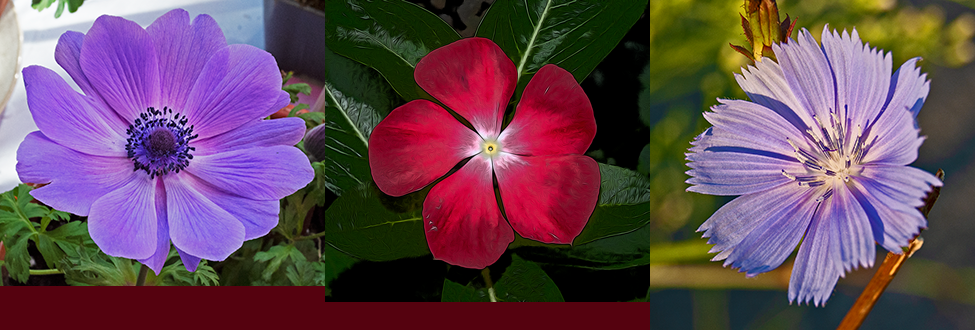
Images by Ebenezer | 21 March 2019 — 3 September 2018 — 18 August 2009
Anemone, Impatiens, Chicory
The color and form of these three beauties is the foundational reason we love flowers — all flowers, native and “invasive.” We were disappointed to learn from our good friend Jeff Hickle that the Chicory (Cichorium intybus) “moves in aggressively to recently disturbed soils, i.e. it likes to follow in the footsteps of construction. Once it gets established, it’ll persist for a long time.” A true gentleman, Jeff was sensitive enough in his message to avoid the term “invasive” because he knows it troubles us here at the Cottage Why we are troubled we can't rightly discern, but words do matter — and we're trapped in this persistent loop of aversion to words like invasive or native when applied to plants and animals. What's worse, some of the folks we admire the most — I mean really admire and respect — are comfortable with the terms. We've learned to avoid the topic in conversation because it contains the potential to cause discord, and we've had enough of that bitter brew — Café Du Monde Coffee and Chicory excepted. As for the image, we captured it during travels through the Hudson River Valley in New York eleven years ago. The Anemone and Impatiens decorated Doghenge (our back patio) a few summers ago.

The Texas Star at Cedar Prairie | Pocola, Oklahoma
Image by Ebenezer | 29 June 2019
The Texas Star
5 Petals of Geometry
Now let us follow four threads, each tied to a singular idea about the power and majesty of Mother Nature's perfect plan — a plan expressed in the design of a sweet little flower with five petals and known by the pop-culture name Texas Star. If you enjoy arcane history and a compelling story, please stick around.
The story begins in the ancient days of Plato and draws to a wrap in a Texas garden in 1880. To bind these four artificial threads into a spiritual lifeline, we call upon the arcane concepts “geometrizing” or “geometrical,” challenging us to imagine how we see the structures and patterns of the Universe.
Please stay with me. Or skim. Or ignore. I respect my readers and hope for the best. One way or another, it's all good here at the Cottage. Your participation makes it all the better.
We looked, but didn't find a direct correlation between Plato and the act of geometrizing, but rather a second-hand thought attributed to Plato by the ancient historian Plutarch, who wrote: “Plato alleges that God forever geometrizes.”
A Strange and Powerful Influence
Our story first surfaces in 1849 in The Southern Lady's Companion, continues in 1867 in Harper's New Monthly Magazine, rises up again in 1871 in The Sailor's Magazine and Seamen's Friend, and comes to a close in 1880 in Volume I of The Life of Jesus Christ for the Young.
So, what might it be? It is the strange and powerful influence of the tiny Texas Star — Sabatia campestris — in the minds and hearts of “infidels,” seekers, and the freshly converted in nineteenth century America. Let us begin.

1. 1849
“I was pursuing one of the academician's most starry dreams,” an unnamed seeker wrote in The Southern Lady’s Companion (1849). “It laid fast hold on my fancy without exciting my faith. I wept to think it could not be true. At length I came to that startling sentence, ‘God geometrizes.’
“Vain reverie! “ I exclaimed as I cast the volume on the ground at my feet. It fell by a beautiful little flower that looked fresh and bright, as if it had just fallen from the bosom of a rainbow. I broke it from its silvery stem, and began to examine its structure. Its stamens were five in number, its great calyx had five parts, its delicate coral base had five, parting with rays expanding like the rays of the Texas Star.
This combination of five in the same blossom appeared to me very singular. I had never thought on such a subject before. The last sentence I had just read in the page of the pupil of Socrates, was ringing in my ears — ‘God geometrizes.’ There was the text written long centuries ago; and here this little flower, in the remote wilderness of the west, furnishes the commentary.
The Epiphany
“There suddenly paused as it were before my eyes a faint flash of light — I felt my heart leap in my bosom. The enigma of the universe was open.
“Swift as thought, I calculated the chances against the production of those three equations of five in only one flower, by any principle devoid of reason to perceive number. I found that there was one hundred and twenty-five chances against such a supposition. I extended this calculation to two flowers, by squaring the sum last mentioned! The chances amounted to the large sum of fifteen thousand six hundred and twenty-five. I cast my eyes around the forest; the old woods were literally alive with those brilliant blooms, where countless bees were humming, and butterflies sipping honey-dews.
“I will not attempt to describe my feelings. My soul became a tumult of radiant thoughts. I took up my beloved Plato from the grass where I had tossed him in a fit of despair. Again and again I pressed him to my bosom, with a clasp tender as a mother's around the neck of her sleeping child. I kissed alternately the book and the blossom, bedewing them both with tears of joy. In my wild enthusiasm, I called to the little birds on the boughs, trilling their cheery farewells to departing day — ‘Sing on, sunny birds; sing on, sweet minstrels. Lo! ye and I have still a God.’ ”

2. 1867
Bending to the North,
It Keeps the Cowboy on Course
The players are Uncle Frank the cowboy, niece Bessie, and a party of friends who are strolling across the prairie. The narrator is George F. Harrington, writing in Harper's New Monthly Magazine (Volume XXXIV 1867). The telling of the tale is a smidge disjointed, but worth a read all the same.
“Do you see those flowers?” asked the Texan, stopping with the party, and waving his hand toward the prairie that rolled from his feet away off north and east to the horizon, brilliant, actually dazzling to the eye, as the sun shone upon it with flowers.
“Once in riding over that prairie to the San Gabriel, my horse fell lame just as I started. I was obliged to go, so I walked leading him.
“Just for the curiosity of it, I began, as I walked, to pick and count the different kinds of flowers I passed.
“I went on to a hundred and twenty-three, and stopped it, tired out.”
The Compass Flower
“This,” he added, taking a small five-leaved flower out of the hand of Bessie, which was loaded as well as her apron with flowers — “this is the Texas Star; it always bends to the north; you had better look at it well, boys, in case you get lost — the compass flower some people call it.
“It’s about the only flower whose name I know. But the cattle are rapidly destroying the flowers — they are all disappearing.”
Just like that, the story ends.
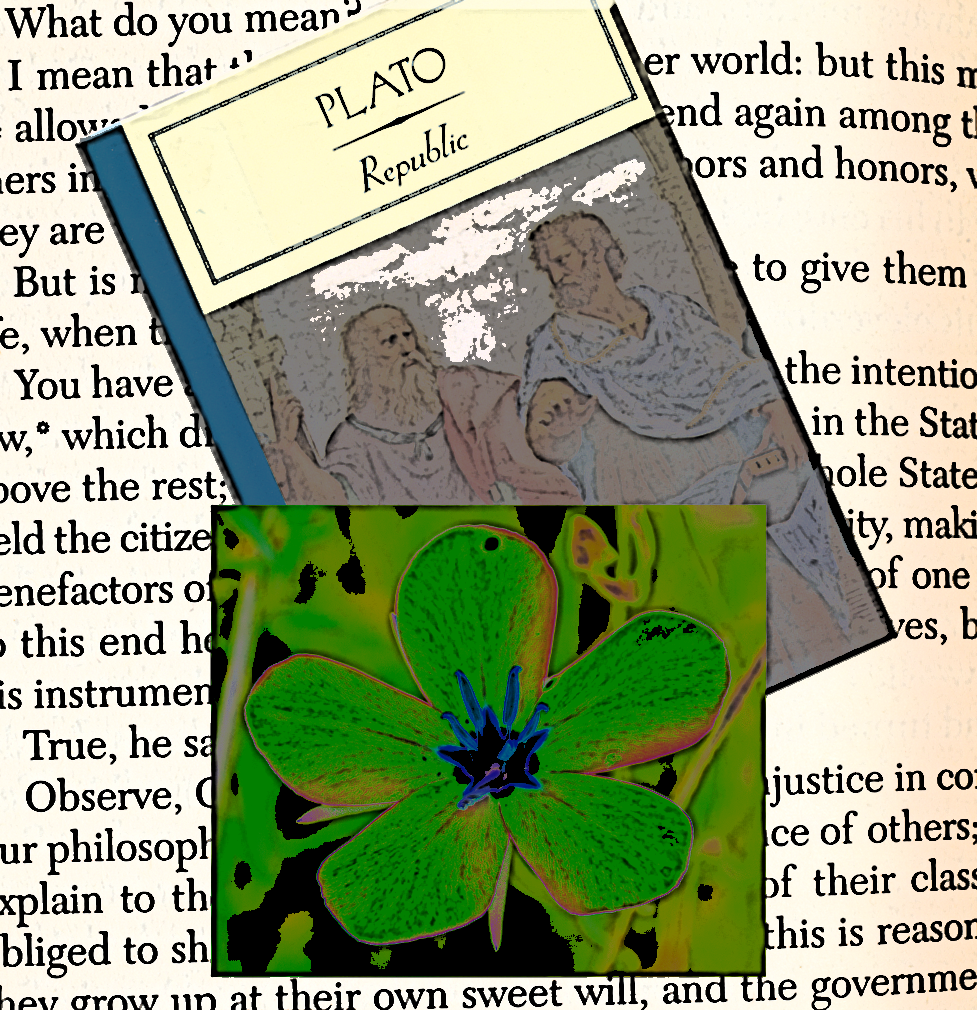
3. 1871
A Plentitude of 5s
From The Sailors Magazine and Seamen's Friend, a publication of the American Seamen’s Friend Society (1871):
“A pleasant writer tells of a Texas gentleman who had the misfortune to be an unbeliever. One day he was walking in the woods, reading the writings of Plato. He came to where that great writer uses the phrase ‘God geometrizing.’ He thought to himself — If I could only see plan and order in God’s works, I could be a believer.
“Just then he saw a little ‘Texas Star’ at his feet. He picked it up and thoughtlessly began to count its petals. He found there were five. He counted the stamens and there were five of them. He counted the divisions at the base of the flower; there were five of them. He then set about multiplying these three fives to see how many chances there were of a flower being brought into existence without the aid of mind, and having in it these three fives. The chances against it were one hundred and twenty-five to one.
The Order of Intelligence
“He thought that was very strange. He examined another flower and found it the same. He multiplied one hundred and twenty-five by itself to see how many chances there were against there being two flowers, each having these exact numbers. He found the chances against it were thirteen thousand six hundred and twenty-five to one.
“But all around him were multitudes of these little flowers; they had been growing and blooming there for years. He thought this showed the order of intelligence, and that the mind that ordained it was God. And so he shut up his book and picked up the little flower and kissed it, and exclaimed: ‘Bloom on, little flowers; sing on, little birds; you have a God and I have a God; the God that made these little flowers made me.’ ”
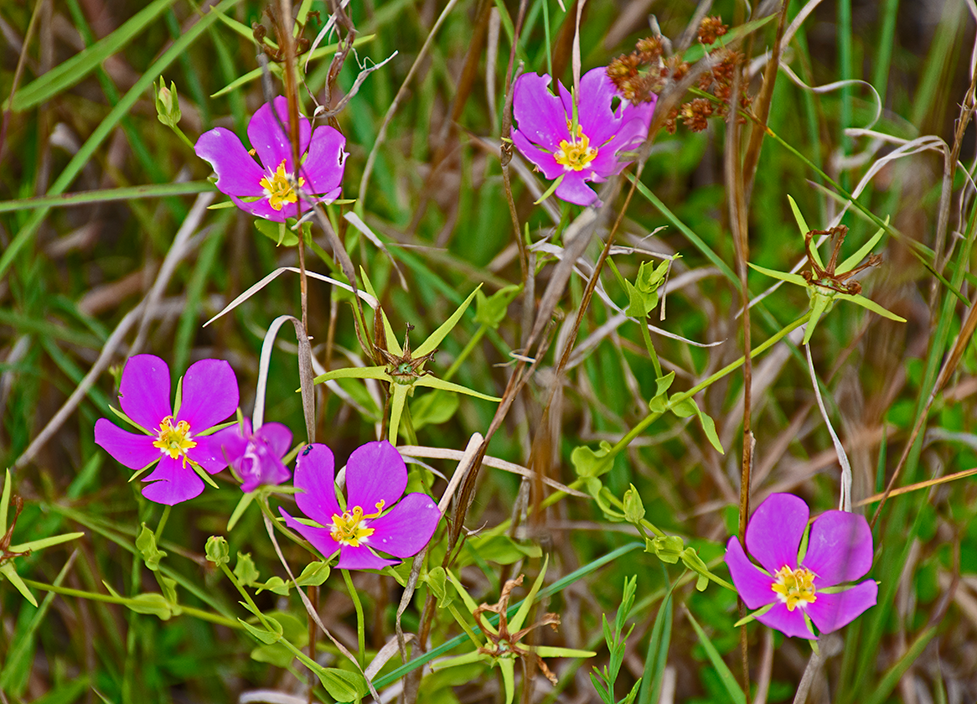
4. 1880
An Infidel Converted
Richard Newton writes in The Life of Jesus Christ for the Young, Volume 1 (1880):
“A Texas man was walking in his garden, pondering the mysteries of the Universe. Looking about him, he began to wonder how things were made and concluded that they must be made by chance.
“Just then he saw close by a sweet little flower, known as the Texas Star. He picked it up and began to examine it. He counted the petals. He found there were five. He counted the stamens. There were five of them. He counted the divisions at the base of the flower; there were five of them. Then he examined another flower. It was the same with that. Another and another were examined. It was the same with all. There were five petals, and five stamens, and so on, in every case.
O, I See
“ ‘How is this?’ he said to himself. ‘If these flowers were made by chance, some of them would have three petals and some two and some none. But now they all have five; never more, and never less. Here is work done by rule. If it is done in this way, there must be some one to do it. And who can that be? O, I see.’
“And then he picked up the little flower, and kissed it, and said:—‘Bloom on, little flower. Sing on little birds; you have a God, and I have a God. The God that made these little flowers made me.’ ”
Haven't we heard this before? Yes, in 1849. And 1871, too. The plagiarism blatantly exhibited here makes the text all that more interesting. Can we call it apocryphal? Perhaps. Or, we could just say the story has legs … and move on. And maybe find our own little Texas Star.
Post Script:
The Prairie Rose Gentian
Many thanks to our friend Joan Reynolds, an Arkansas Master Naturalist and recognized expert in plant identification. Joan's help in identifying our precious little flower from a photograph is greatly appreciated.
“I think this is Sabatia campestris (aka Prairie Rose Gentian) in the Gentianacea family,” she wrote. “I am basing that on the fact that the stems do not look winged as you would expect on our other pink gentian, S. angularis (Rose Pink), and the sepals are about as long as the petals, too. … S. angularis is fairly common around here on roadsides. S. campestris I tend to think of as a prairie or glade plant. They are both beautiful and this has been a stellar year for them.”
At last report, there exist seventeen species of the Sabatia genus. Thomas Nuttall in his Journal of Travels Into the Arkansa Territory collected a specimen of Sabatia campestris, aka Sabatia campestris Nutt. The flowers shown here were captured with pixels in the same stretch of Earth Mr. Nuttall walked two hundred years ago. That's amazing. PS: Nuttall spelled it that way: Arkansa.



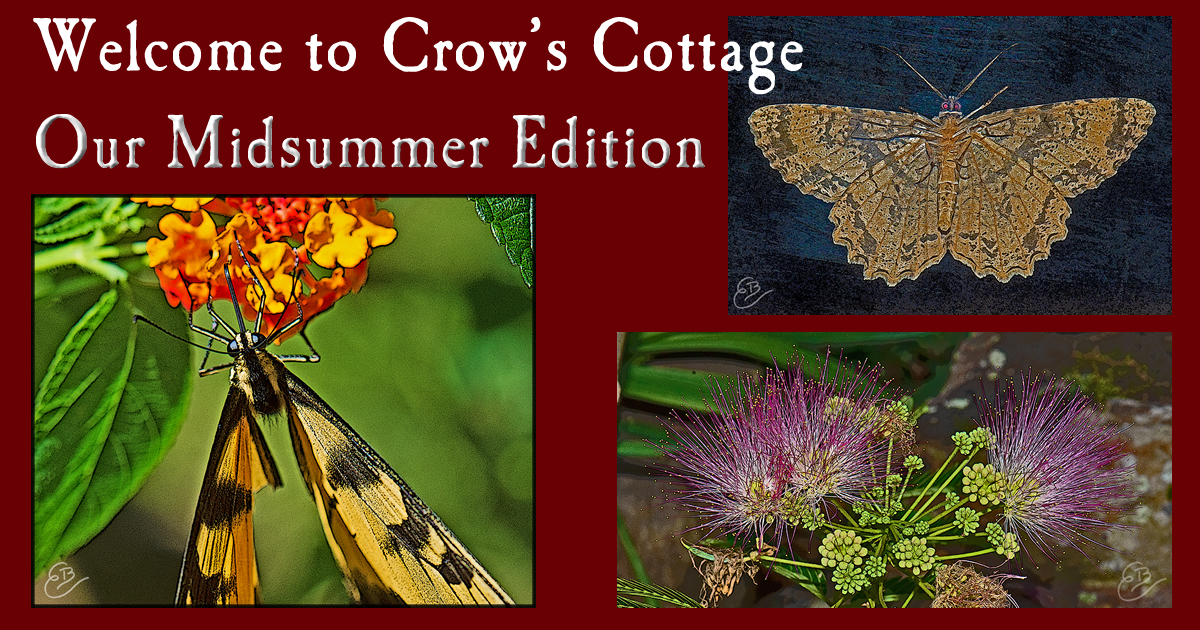



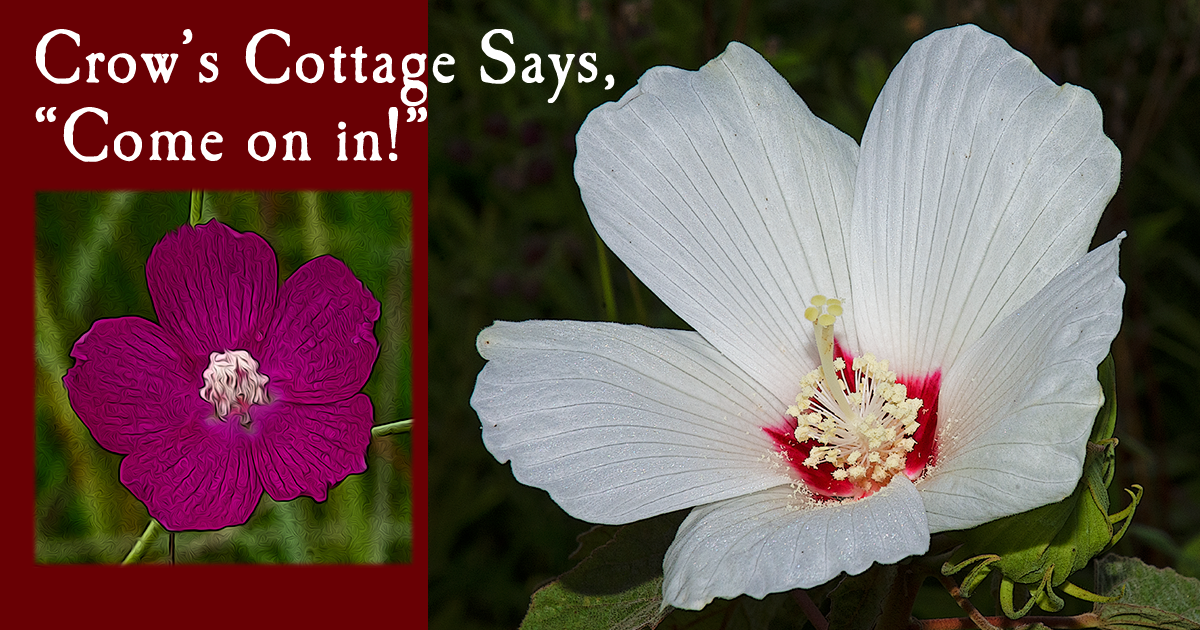

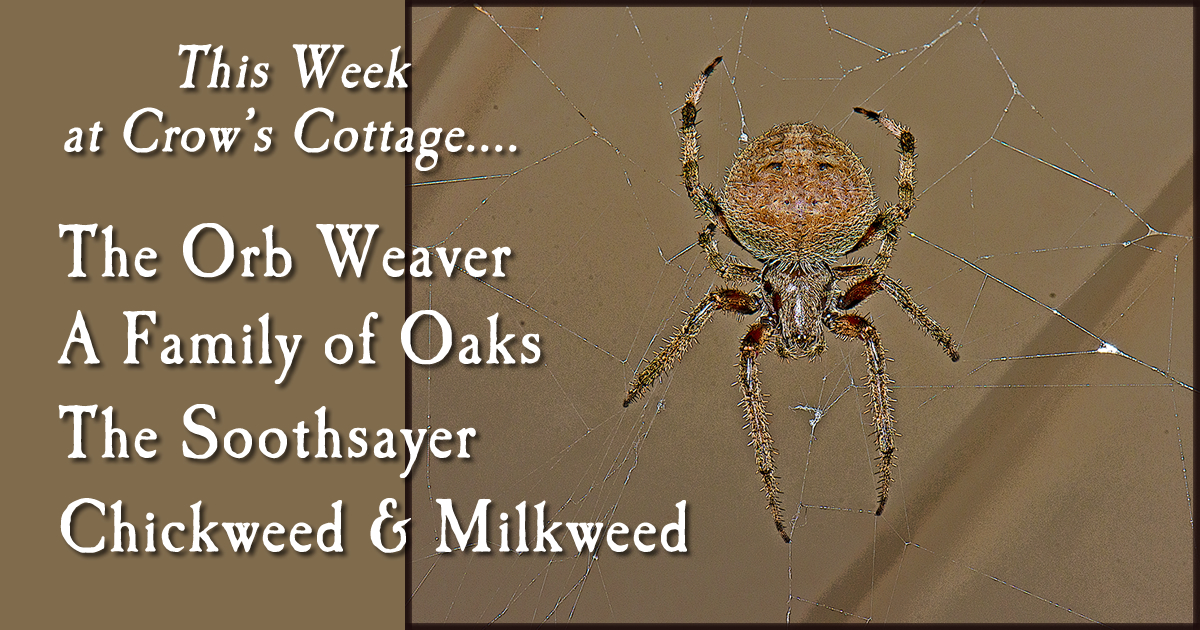


As always, we invite you to write us letter of encouragement or correction. You can even chastise us if you're respectful. Expect a courteous and timely reply. And let us know if you'd like to receive a notice about new features. Our address is ebenezer@crowscottage.com




